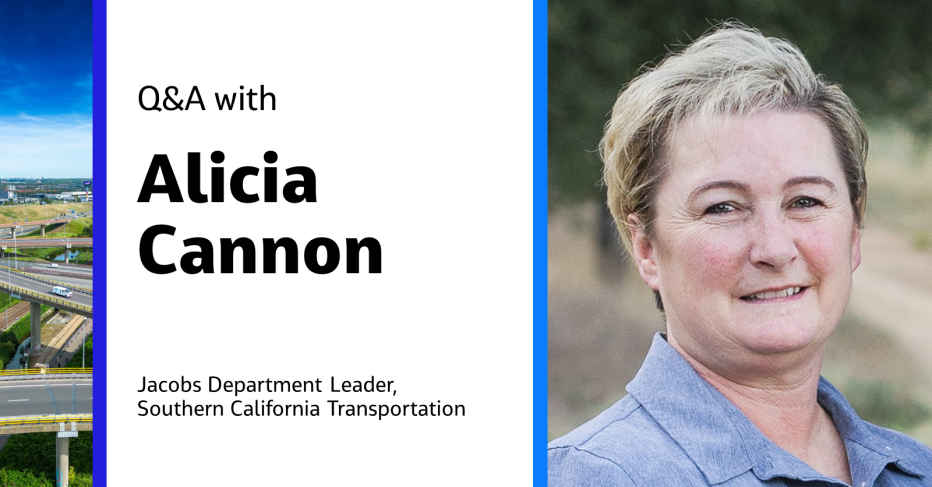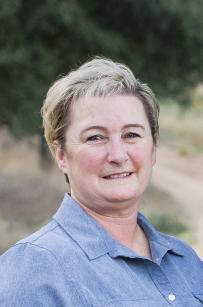
Decisions made on transport infrastructure can influence the shape and success of our cities for generations, at a time of rapidly changing work and living patterns.
In California, where the transportation system will need to support an expected 45 million residents by 2050, developing integrated, sustainable mobility options has never been more important, or complex.
With high rankings across all modes of transport as ranked by Engineering News-Record, Jacobs guides our clients to deliver on the state’s long-range vision to expand economic opportunities, create a low-carbon transportation system, advance transportation equity and improve quality of life for Californians.
We keep people and goods moving smoothly into the future with the help of talented teammates like Alicia Cannon, one of our transportation leaders. In this Q&A, we connect with Alicia about local transportation design opportunities and how we plan for and deliver California’s transport infrastructure and solutions for tomorrow.
Tell us a bit about your role as a department leader for the Southern California transportation market.
In my role, I lead our transportation engineers across our Southern California offices. This encompasses roadway and highway engineers, transportation planners, and structural engineers. Additionally, this position allows me to mentor our Group Leaders, who - in turn - can guide their own teams. Moreover, this role provides me with valuable insights and more face time with management and financial aspects. It affords me the opportunity to view things from a business perspective and ensure that we’re making decisions that align with the overall success of the organization. By engaging our Group Leaders in this mindset, we can foster a culture where everyone brings their whole selves to work, aligns on our business objectives, and helps ensure the well-being of the business.
What are the biggest challenges in transportation design?
Two main challenges designers are facing in transportation design are congestion and emerging technologies. In California for example, there’s a focus on reducing vehicle miles traveled, resulting in designers thinking differently about how to provide the best and most creative solutions to manage congested corridors. Second, designers are constantly exploring and applying emerging technologies to improve the efficiency and safety of roadway facilities. These technologies require designers to develop new skillsets and look beyond past experiences and best practices to future-thinking concepts that leverage innovative tools and solutions to solve the industry’s toughest challenges.
Back to the California example, we’re seeing projects today less focused on adding capacity, and more focused on providing multi-modal solutions, integrating active transportation, roadway and transit and rail to provide more choices to transportation users. This can be a challenge in the Inland Empire (San Bernardino and Riverside Counties), which is a hub of shipping and distribution of many of the nation’s goods. The Inland Empire experiences heavy truck traffic limited public transportation facilities and a congested roadway network. Emerging technologies have the potential to solve some of these challenges and interconnect our transportation facilities to improve safety and traffic flow.
How do you help clients think differently to respond to future challenges?
My approach is to stay at the forefront of the challenges, listen to our clients’ needs, and work with our technologists and subject matter experts to offer efficient, cutting-edge solutions. We add value to our engineering so our clients can see first-hand how we can deliver the project’s purpose and vision more efficiently and cost effectively. I like to bring in technical experts in subject matter areas to share lessons learned with our clients to continue building on that value
We also help our clients respond to future challenges by staying ahead of the curve and developing new technology tools, such as our StreetLight InSight® analytics tool, which harnesses connected devices and data to measure vehicle, transit, bike, and foot traffic virtually anywhere, and other artificial intelligence (AI)-based innovations. By offering a suite of technological innovations to our clients, we help them think differently in the delivery of their overall program and consider new ways to impact how people and goods move about.
What are some of the biggest opportunities ahead for transportation design?
There are several opportunities shifting transportation design, including implementation of technology solutions such as smart highways, integrating multi-modal infrastructure into each project, and growing initiatives focused on re-connecting communities and wildlife connectivity. These areas are emerging and becoming more prevalent in transportation project development. At the state and federal level, a lot of the current funding initiatives are competitive, so incorporating some of these elements into an agency’s projects allows the project to be better positioned for success and be more competitive for being awarded a grant.
I’ve personally taken the initiative to bring Jacobs’ deep domain of experts in front of our Inland Empire clients. This way, as our clients look to explore emerging technologies to improve safety and traffic flow on our highway network, we can introduce our global team from the U.K. and Australia to share the smart systems being used abroad, and lessons learned to-date on implementing their smart highway networks. This has yielded excellent results, as one of our clients are implementing a pilot program for a segment of smart highways in the Temecula, California area. Additionally, with a current focus on the impacts of roadway and transportation development on the environment and wildlife connectivity, there’s a growing need to provide access solutions on existing corridors that satisfy current legislation and improve the overall environment.
There’s a strategic effort in Riverside County, California, to reduce traffic and improve infrastructure. How is Jacobs getting involved?
The incorporation of multi-modal infrastructure, including transit lanes, active transportation, and direct connections to rail stations, are being evaluated as part of the planning and implementation of upcoming projects. Our transportation planning group has already started engaging on those projects to help integrate these new and innovative ideas early in the project’s development.
Is there a project you’re particularly proud of?
I had the opportunity to be engaged on an award-winning project located in California’s City of Murrieta and unincorporated Riverside County, from the early planning and environmental phase, through design and construction. The six-lane urban arterial highway with limited access and signalized intersections at major crossroads extended the existing road approximately three miles on a new alignment between Antelope Road and State Route 79. This project also incorporated three major wildlife structures to accommodate wildlife movement within known linkage areas. Our team worked closely with local government agencies to get the environmental documentation approved, secure all permits and prepare the final design plans, which have been constructed and is now open to the public as of December 2023.
As a result, the project won two awards, the 2019 APWA Large Project of the Year Award, and the Caltrans 2020 Excellence in Transportation Award. This was a proud moment for me to see the project recognized with these awards, but to also be engaged in the implementation of this project all the way to completion and be there for the ribbon-cutting with the entire project team, agency representatives and local community members.
About the interviewee

Alicia Cannon is Jacobs’ Department Leader for the Southern California transportation market and is based in Ontario, California. She was born and raised in the Inland Empire and has spent most of her career working on local projects and improving the transportation system.
Starting her journey right out of high school, she balanced her education with her responsibilities at a local engineering firm. And while starting her family early, she remained committed to her education and career. Joining Jacobs in 2001 was a significant milestone in her career. Here, she not only honed her technical skills but also embarked on her path as a project manager. Her early experiences and the knowledge she gained became a valuable asset, enabling her to mentor the next generation of leaders and to challenge her staff in finding optimal solutions on projects.
Alicia’s innovative, communicative and hands-on approach has been key to her successful collaboration with clients. Her deep understanding of institutional policies and procedures, backed by 30 years of experience in highway/roadway engineering and project management, has enabled her to successfully deliver numerous PS&E contracts. Her focus on practical and sustainable design underscores her commitment to realistic and implementable solutions. Alicia’s journey is a testament to her dedication, resilience and leadership in the Southern California transportation market.
Outside of work, Alicia cherishes spending time outdoors, whether it’s hiking through scenic trails or simply enjoying the fresh air. However, her greatest joy comes from being with her family and spending time with her grandkids – they truly light up her life!














































